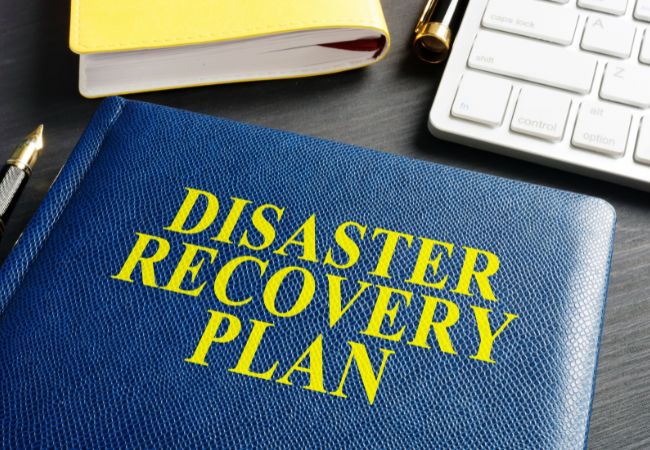Having a solid disaster recovery plan is crucial for businesses of all sizes. This section will explore the importance of disaster recovery plans and provide a definition of what a disaster recovery plan entails.

Importance of Disaster Recovery Plans
In today's digital age, businesses heavily rely on technology and data to operate efficiently. However, unexpected events such as natural disasters, cyber-attacks, or system failures can disrupt operations and lead to significant financial loss. This is where disaster recovery plans come into play.
A disaster recovery plan is designed to minimize the impact of these unforeseen events by outlining the necessary steps to recover and restore business operations. Implementing a comprehensive disaster recovery plan offers several key benefits:
- Minimizing Downtime: A well-prepared plan ensures that businesses can resume their operations as quickly as possible, minimizing the potential loss of revenue and productivity.
- Protecting Data: Data is a critical asset for businesses. A disaster recovery plan includes strategies for data backup and recovery, safeguarding important information, and preventing data loss.
- Maintaining Customer Trust: By being prepared for potential disasters, businesses can assure their customers that their services will remain uninterrupted, maintaining trust and loyalty.
- Complying with Regulations: Many industries have specific regulations and compliance requirements related to data protection and business continuity. Implementing a disaster recovery plan helps businesses meet these obligations.
Definition of a Disaster Recovery Plan
A disaster recovery plan is a documented set of procedures and strategies that outline how a business will respond to and recover from various disruptions or disasters. It encompasses the processes and actions needed to mitigate risks, restore critical systems, and resume normal operations.
A well-developed disaster recovery plan typically includes the following key elements:
- Risk Assessment: Identifying potential threats and vulnerabilities that could impact business operations, such as natural disasters, power outages, or malicious attacks.
- Business Impact Analysis: Evaluating the potential consequences of a disruption on various aspects of the business, including financial, operational, and reputational impacts.
- Recovery Objectives: Establishing clear objectives and priorities for recovery, such as recovery time objectives (RTOs) and recovery point objectives (RPOs), which define the acceptable time frame for restoring systems and data.
- Responsibilities and Roles: Assigning roles and responsibilities to individuals or teams involved in the disaster recovery process, ensuring clear communication and coordination during an incident.
- Data Backup and Recovery: Implementing strategies and technologies to regularly back up critical data and develop procedures for restoring data in the event of a loss.
- Communication Protocols: Establishing communication channels and protocols to keep stakeholders informed during a crisis, including employees, customers, suppliers, and regulatory authorities.
- Testing and Training: Regularly testing and evaluating the effectiveness of the disaster recovery plan through drills and simulations, as well as providing training to employees to ensure they are familiar with their roles and responsibilities.
Understanding the importance of disaster recovery plans and having a clear definition of what they entail enables businesses to take proactive steps to safeguard their operations, protect their data, and ensure business continuity in the face of unforeseen events.
Assessing Risks and Vulnerabilities
To create an effective disaster recovery plan, it's crucial to assess the risks and vulnerabilities that your business may face. This involves identifying potential threats and evaluating the impact they could have on your business operations.
Identifying Potential Threats
The first step in assessing risks and vulnerabilities is to identify the potential threats that could disrupt your business. These threats can be natural disasters, such as earthquakes, floods, or storms, or they could be human-induced, such as cyberattacks, power outages, or equipment failures.
Understanding the specific threats your business is susceptible to allows you to develop strategies to mitigate their impact. Consider conducting a risk assessment survey, consulting with experts, or analyzing historical data to identify the most likely threats for your industry and geographic location.
Evaluating Business Impact
Once you have identified potential threats, it's important to evaluate the potential impact they could have on your business. This involves assessing the severity and duration of the disruption that each threat could cause.
To evaluate business impact, consider the following factors:
- Financial Impact: Determine the potential financial losses your business could incur as a result of the identified threats. This includes direct costs, such as damage to property or equipment, as well as indirect costs, such as lost sales or productivity.
- Operational Impact: Assess how the threats could affect your business operations. This includes the ability to access critical systems, deliver products or services, maintain customer support, and meet regulatory requirements.
- Reputation Impact: Consider the potential damage to your business's reputation that could result from a disruption. This includes the impact on customer trust, brand image, and relationships with stakeholders.
- Legal and Compliance Impact: Evaluate the potential legal and compliance implications that could arise from a disruption. This includes any legal obligations or industry regulations that your business must adhere to.
Evaluating the potential impact of each threat helps prioritize your disaster recovery efforts and allocate resources accordingly. This ensures that your plan focuses on the most critical areas of your business, allowing for effective response and recovery.
Developing a Comprehensive Plan
When it comes to safeguarding your business from potential disasters, developing a comprehensive plan is crucial. This section focuses on two essential components of a disaster recovery plan: establishing clear objectives and designating responsibilities.
Establishing Clear Objectives
Before diving into the details of your disaster recovery plan, it's important to establish clear objectives. These objectives outline the overarching goals and outcomes you want to achieve through your plan. By defining your objectives, you provide a clear direction for the entire disaster recovery process.
Some common objectives to consider include:
- Minimizing downtime: The primary goal of a disaster recovery plan is to reduce the downtime your business experiences in the event of a disaster. This objective ensures that your business can resume its operations as quickly as possible, minimizing the impact on productivity and revenue.
- Protecting critical data: Data is a valuable asset for any business. Your disaster recovery plan should include objectives that focus on protecting and recovering critical data in a timely manner. This ensures that important information, such as customer data, financial records, and intellectual property, remains secure and accessible.
- Ensuring employee safety: In the event of a disaster, the safety and well-being of your employees should be a top priority. Consider including objectives that address employee safety, such as establishing evacuation procedures, providing emergency training, and ensuring clear communication channels.
Establishing clear objectives sets the foundation for a focused and effective disaster recovery plan.
Designating Responsibilities
A successful disaster recovery plan requires clear roles and responsibilities for the individuals involved. Designating responsibilities ensures that everyone knows their role in implementing the plan and can act promptly and effectively when a disaster strikes.
To assign responsibilities, consider the following:
- Recovery team: Form a dedicated team responsible for executing the disaster recovery plan. This team should consist of individuals with expertise in technology, security, and operations. Assign a team leader who will oversee the recovery efforts and coordinate communication among team members.
- IT personnel: Identify IT personnel who will be responsible for data backup, recovery, and system restoration. Clearly define their roles and responsibilities, including the procedures they need to follow in case of a disaster.
- Communication channels: Establish clear communication protocols and designate individuals responsible for communication during and after a disaster. This includes notifying employees, customers, vendors, and other stakeholders about the situation and providing updates on the recovery progress.
Assigning specific responsibilities to individuals or teams ensures a coordinated and efficient response during a disaster. Regularly reviewing and updating these responsibilities helps adapt to organizational changes and ensures that everyone is aware of their roles.

Essential Components of a Disaster Recovery Plan
To effectively safeguard your business, a well-designed disaster recovery plan is essential. This plan should encompass various components that address data backup and recovery strategies, communication protocols, and testing and training procedures.
Data Backup and Recovery Strategies
Data is the lifeblood of any business, and having a robust backup and recovery strategy is crucial to ensure its protection. A disaster recovery plan should include the following key elements:
- Data Inventory and Classification: Identify and categorize your business's critical data, determining its importance and priority.
- Regular Data Backups: Establish a regular schedule for backing up your data, taking into account the frequency of updates and changes. This may range from daily backups for real-time data to weekly or monthly backups for less dynamic information.
- Offsite Data Storage: Store backup data in a secure offsite location to protect against physical damage, such as fires or floods at the primary location.
- Data Recovery Procedures: Develop clear and tested procedures for restoring data from backups, ensuring that your business can quickly recover from a disaster.
Communication Protocols
During a crisis, effective communication is paramount to minimize confusion and facilitate a coordinated response. Here are some important considerations for communication protocols within a disaster recovery plan:
- Emergency Contact Information: Compile a comprehensive list of emergency contact information for all key stakeholders, including employees, vendors, clients, and relevant authorities.
- Notification Procedures: Establish clear procedures for notifying employees and other stakeholders about the activation of the disaster recovery plan, including designated communication channels and protocols.
- Internal and External Communication: Define communication channels and protocols for both internal communication among your team members and external communication with clients, vendors, and authorities.
- Media Relations: If applicable, outline guidelines for interacting with the media during a crisis, ensuring that your business presents a consistent and controlled message.
Testing and Training Procedures
A disaster recovery plan is only effective if it has been regularly tested and the relevant personnel are well-trained. Consider the following aspects when developing testing and training procedures:
- Testing Scenarios: Design and execute various disaster scenarios to test the effectiveness of your plan. This can include simulated events like power outages, data breaches, or natural disasters.
- Training Programs: Conduct regular training sessions to educate employees on their roles and responsibilities during a crisis, ensuring they understand the procedures outlined in the plan.
- Documentation and Evaluation: Keep detailed records of testing and training activities, including any identified weaknesses or areas for improvement. Regularly review and update the plan based on these evaluations.
Incorporating these essential components into your disaster recovery plan prepares your business to navigate potential crises and ensure operational continuity. Regularly reviewing and updating your plan helps adapt to new threats and technologies, ensuring your business remains resilient in the face of adversity.
Implementing the Plan
Once you have developed a comprehensive disaster recovery plan, it's time to put it into action. Implementing the plan involves executing the necessary steps and processes to ensure a smooth recovery in the event of a disaster. This section focuses on two crucial aspects of plan implementation: the execution and activation process, and the ongoing monitoring and updating of the plan.
Execution and Activation Process
When a disaster strikes, it's essential to have a well-defined execution and activation process in place. This process outlines the specific actions and procedures to be followed to initiate the recovery plan. It should include clear instructions on who is responsible for what tasks and how they should be carried out.
During the execution and activation process, it's important to refer to the plan's established objectives and designated responsibilities. This ensures that everyone involved is aware of their roles and responsibilities, promoting efficient and coordinated efforts.
The execution and activation process typically involves the following steps:
- Alert and notification: Promptly notify the designated individuals or teams responsible for initiating the recovery plan. This can be done through various communication channels such as email, phone calls, or emergency alert systems.
- Assemble the recovery team: Bring together the designated individuals who will lead and support the recovery efforts. This team should include representatives from different departments or areas of expertise, ensuring a comprehensive approach to the recovery process.
- Assess the situation: Evaluate the extent of the disaster and the impact it has had on the business operations. This assessment helps determine the appropriate actions to be taken and the priorities for recovery.
- Execute recovery procedures: Follow the predefined procedures and steps outlined in the disaster recovery plan. This may involve restoring data from backups, setting up alternative work environments, or engaging external service providers if necessary.
- Communicate and coordinate: Maintain open lines of communication among the recovery team and stakeholders. Regularly update them on the progress of the recovery efforts and any changes in the plan or procedures.
By having a well-defined execution and activation process, businesses can respond effectively to disasters, minimizing downtime and ensuring a swift recovery.
Monitoring and Updating the Plan
Implementing a disaster recovery plan is not a one-time task; it requires ongoing monitoring and updating to remain effective. Regular monitoring helps identify any gaps or weaknesses in the plan, allowing for timely adjustments and improvements. This ensures that the plan remains up-to-date and aligned with the evolving needs and risks of the business.
Monitoring and updating the plan involves the following activities:
- Review and evaluation: Conduct periodic reviews of the plan to assess its effectiveness and identify areas for improvement. This can be done through simulations, tabletop exercises, or real-life scenario evaluations.
- Risk assessment: Continuously evaluate the risks and vulnerabilities faced by the business. Stay informed about emerging threats and ensure that the plan accounts for these potential risks.
- Training and awareness: Provide regular training sessions to employees involved in the recovery process. This helps them stay familiar with their roles and responsibilities and keeps them prepared to execute the plan effectively.
- Document and communicate updates: Document any changes or updates to the plan and ensure that the revised version is communicated to all relevant stakeholders. This helps maintain consistency and ensures that everyone is working with the most current version of the plan.
Actively monitoring and updating the plan allows businesses to adapt to new challenges and technologies, ensuring that their disaster recovery efforts remain robust and effective over time.

Ensuring Business Continuity
To safeguard your business from potential disasters, it is crucial to prioritize business continuity. This involves implementing measures to ensure that essential operations can continue seamlessly, even in the face of unexpected events. Two key aspects of achieving business continuity are regular reviews and continuous improvement and adaptation.
Importance of Regular Reviews
Regular reviews of your disaster recovery plan are essential to ensure its effectiveness and relevance over time. As your business evolves and technology advances, potential risks and vulnerabilities may change. By conducting periodic reviews, you can identify any gaps or areas for improvement in your plan and make necessary adjustments.
During these reviews, it is important to involve key stakeholders, such as IT professionals and department heads, to gather their insights and perspectives. Evaluate the performance of your plan based on real-world scenarios or hypothetical situations. Assess whether your plan adequately addresses various types of disasters, such as natural disasters, cybersecurity breaches, or system failures.
Maintaining a record of these reviews and their outcomes is valuable for tracking progress and ensuring accountability. Regularly updating and revising your disaster recovery plan based on these reviews helps ensure its continued effectiveness and alignment with your business goals.
Continuous Improvement and Adaptation
The landscape of potential disasters and the technology landscape are constantly evolving. As such, it is crucial to prioritize continuous improvement and adaptation in your disaster recovery plan. This involves staying up to date with the latest industry trends, best practices, and technological advancements.
Continuous improvement can be achieved through ongoing training and education for your IT staff and employees. This ensures that everyone is aware of their roles and responsibilities in the event of a disaster and is equipped with the necessary knowledge and skills to execute the plan effectively.
Additionally, it is important to establish a feedback loop within your organization. Encourage employees to provide suggestions or feedback on the disaster recovery plan and its implementation. This feedback can help identify areas for improvement and innovation, ensuring that your plan remains robust and adaptable.
Fostering a culture of continuous improvement and adaptation enables your business to proactively respond to emerging threats and challenges. Regularly reassessing and enhancing your disaster recovery plan helps protect your business and minimize the impact of potential disruptions.
Remember, disaster recovery is an ongoing process, not a one-time task. By regularly reviewing and continuously improving your plan, you can enhance your business's resilience and ensure its long-term success.
Don't Let Disaster Destroy Your Business
A robust Disaster Recovery Plan is your lifeline in the face of unexpected challenges. But remember, a plan is only as strong as its execution. LK Tech, an IT services provider in Cincinnati, can help you transform your plan into a reality. Our experts provide tailored solutions to safeguard your business.
Ready to protect your future? Contact LK Tech today for a free consultation!


